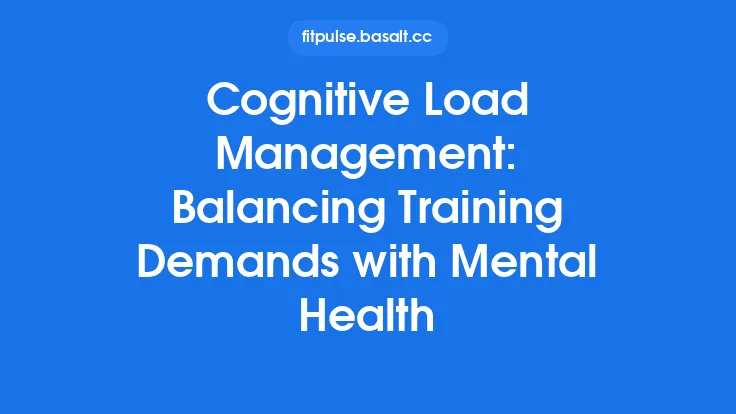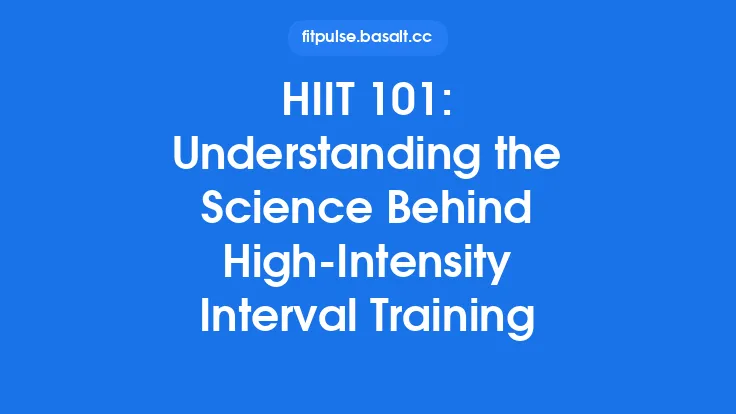In high‑stakes moments—whether it’s the final seconds of a basketball playoff, a penalty shoot‑out in soccer, or a crucial point in a tennis match—athletes must translate years of training into split‑second decisions. The bottleneck is rarely physical; it is often the brain’s capacity to process information, manage stress, and execute a response before the window of opportunity closes. Cognitive load management is the discipline of optimizing mental resources so that decision speed remains high even under intense pressure. Below is a comprehensive guide that unpacks the theory, the neurophysiology, and the practical tools coaches and athletes can use to keep the mind sharp when it matters most.
Understanding Cognitive Load in Sports
Cognitive load refers to the amount of mental effort required to process information, store it in working memory, and generate an appropriate response. In the context of sport, three distinct types of load interact:
| Load Type | Description | Typical Sports Example |
|---|---|---|
| Intrinsic Load | The inherent complexity of the task itself (e.g., number of variables to consider). | A quarterback reading a defense with multiple coverage schemes. |
| Extraneous Load | Irrelevant or poorly presented information that distracts from the core task. | Overly noisy sidelines, confusing coaching instructions, or cluttered visual cues. |
| Germane Load | The mental effort devoted to building schemas and automatisms that support performance. | Developing a mental script for a set‑piece in soccer. |
Effective cognitive load management aims to minimize extraneous load, balance intrinsic load with the athlete’s expertise, and optimally allocate germane load to reinforce useful patterns. When extraneous load spikes—such as during a hostile crowd or a sudden rule change—working memory can become saturated, leading to slower or erroneous decisions.
The Neuroscience of Decision Speed Under Pressure
Working Memory and the Prefrontal Cortex
The prefrontal cortex (PFC) orchestrates working memory, attention, and executive control. Under calm conditions, the PFC can maintain multiple pieces of information (e.g., opponent positioning, teammate location, and game clock) and integrate them into a decision. However, acute stress triggers a surge of catecholamines (adrenaline and cortisol) that temporarily impair PFC function, shifting control to more primitive brain regions such as the basal ganglia and amygdala. This shift favors habitual or reflexive actions over deliberative choices, which can be advantageous if the habit is well‑trained, but detrimental if the situation demands a novel response.
The Drift‑Diffusion Model (DDM)
A widely accepted computational framework for decision speed is the drift‑diffusion model. In DDM, evidence accumulates over time toward one of two decision thresholds. The drift rate reflects the quality of information (higher when cues are clear), while the boundary separation reflects the amount of evidence required before committing to a choice (larger when the athlete is risk‑averse). Stress typically reduces drift rate (noisier perception) and narrows boundary separation (premature commitment), both of which can accelerate decisions but at the cost of accuracy. Training that improves cue discrimination and confidence can counteract these stress‑induced shifts.
Neural Efficiency and Automaticity
Repeated exposure to sport‑specific patterns leads to neural efficiency: fewer neurons fire to achieve the same outcome, and the signal-to-noise ratio improves. Functional MRI studies show that elite athletes exhibit reduced PFC activation during well‑learned tasks, indicating that the decision process has become more automatic and less cognitively demanding. This automaticity frees working memory capacity for handling unexpected variables, thereby preserving decision speed under pressure.
Assessing Cognitive Load and Decision Latency
Before implementing interventions, it is essential to establish a baseline of an athlete’s cognitive load and decision speed. Several evergreen assessment tools are available:
- Dual‑Task Paradigm
- Method: Athletes perform a primary sport‑specific task while simultaneously responding to a secondary, unrelated stimulus (e.g., auditory tone).
- Interpretation: Increased reaction time or error rate on the secondary task indicates high intrinsic or extraneous load.
- Eye‑Tracking Metrics
- Fixation Duration: Longer fixations suggest difficulty extracting relevant information.
- Saccade Frequency: Excessive saccades can reflect scanning overload.
- Heart Rate Variability (HRV) Monitoring
- Lower HRV during competition correlates with heightened sympathetic activation, which often coincides with elevated cognitive load.
- Subjective Load Scales
- The NASA‑TLX (Task Load Index) can be adapted for sport contexts, allowing athletes to rate mental demand, effort, and frustration after simulated scenarios.
- Reaction‑Time Tests
- Simple vs. choice reaction time tasks, administered on a tablet or laptop, provide quantitative data on processing speed. The difference between simple and choice reaction times offers insight into decision‑making latency.
Collecting these data points over multiple sessions creates a performance profile that highlights when and where cognitive load spikes, guiding targeted interventions.
Strategies to Reduce Extraneous Load
- Simplify Communication
- Use concise, standardized cue words or hand signals. Consistency reduces the decoding time required during play.
- Environmental Control
- Where possible, limit visual clutter on the field (e.g., clear markings, uniform jersey colors). During training, simulate crowd noise gradually to habituate athletes without overwhelming them.
- Pre‑Performance Briefs
- Limit the amount of tactical information delivered immediately before competition. Focus on two to three key priorities rather than a comprehensive game plan.
- Information Chunking
- Group related cues into meaningful clusters (e.g., “high press on the left side”). This reduces the number of discrete items the athlete must hold in working memory.
- Use of External Memory Aids
- Simple visual markers (e.g., colored cones) can offload the need to remember positional instructions, allowing the brain to focus on dynamic decision making.
Building Automaticity Through Chunking and Pattern Recognition
Automaticity is the cornerstone of rapid decision making. The pathway from conscious deliberation to automatic response involves three stages:
- Acquisition – Learning the basic elements of a pattern (e.g., recognizing a “pick‑and‑roll” in basketball).
- Consolidation – Repeated exposure consolidates the pattern into long‑term memory, strengthening synaptic connections.
- Automation – The pattern can be retrieved with minimal conscious effort, freeing working memory.
Practical steps to accelerate this process:
- Deliberate Repetition of Core Scenarios
Focus on a limited set of high‑frequency game situations. Repetition should be high‑quality (correct execution) rather than high‑volume of varied, low‑frequency events.
- Progressive Abstraction
Begin with concrete, full‑field simulations, then gradually strip away extraneous details (e.g., reduce the number of players) to highlight the core pattern. This encourages the brain to encode the underlying schema rather than surface features.
- Mental Chunking Drills
Have athletes verbally describe a scenario in “chunks” (e.g., “defender steps left → attacker cuts inside → pass to wing”). Repeating this narrative reinforces the neural pathways associated with the pattern.
- Cross‑Modal Reinforcement
Pair visual cues with auditory or kinesthetic cues (e.g., a specific foot placement sound). Multi‑sensory encoding improves retention and retrieval speed.
Arousal Regulation and Stress Inoculation
Optimal arousal follows the classic Inverted‑U relationship: too little arousal leads to sluggishness, too much leads to anxiety and impaired cognition. Athletes can learn to self‑regulate arousal through:
- Controlled Breathing Techniques
- Box breathing (4‑4‑4‑4 seconds) stabilizes heart rate and reduces sympathetic dominance.
- Resonant breathing (≈6 breaths per minute) maximizes HRV, supporting PFC function.
- Progressive Muscle Relaxation (PMR)
Systematically tensing and releasing muscle groups lowers overall physiological tension, which translates to clearer mental processing.
- Stress Inoculation Training (SIT)
Expose athletes to graded stressors (e.g., simulated crowd noise, time pressure) in a controlled environment. Over repeated exposures, the physiological stress response attenuates, preserving cognitive capacity during real competition.
- Pre‑Performance Routines
A consistent sequence of actions (e.g., a specific warm‑up, a short visualization, a trigger word) signals the brain that the upcoming task is familiar, reducing surprise‑induced arousal spikes.
Mental Rehearsal and Visualization Techniques
Visualization is more than “seeing” a play; it is a neural rehearsal that activates many of the same brain regions used in actual execution. Effective mental rehearsal follows these principles:
- Multisensory Detail
Include visual, auditory, kinesthetic, and even olfactory cues. The richer the simulation, the stronger the neural imprint.
- Perspective Shifts
Alternate between first‑person (as if you are the athlete) and third‑person (observing yourself) viewpoints. This dual perspective enhances both procedural memory and strategic awareness.
- Outcome‑Independent Practice
Focus on the process (“I receive the ball, scan, and pass”) rather than the result (“I score”). This reduces performance anxiety and keeps the cognitive load on the decision pathway rather than the outcome.
- Temporal Compression
Practice entire sequences in a condensed timeframe (e.g., a 10‑second play visualized in 5 seconds). This trains the brain to accelerate information processing.
Regular mental rehearsal—ideally 10‑15 minutes daily—strengthens the germane load, making the decision pathway more resilient under pressure.
Recovery, Nutrition, and Sleep for Cognitive Resilience
Physical recovery strategies also support cognitive performance:
- Sleep Hygiene
Aim for 7‑9 hours of uninterrupted sleep. Slow‑wave sleep consolidates procedural memory, while REM sleep enhances pattern integration and creativity—both essential for rapid decision making.
- Nutrient Timing
- Complex Carbohydrates before training sustain glucose supply to the brain.
- Omega‑3 Fatty Acids (EPA/DHA) improve neuronal membrane fluidity, supporting faster synaptic transmission.
- Caffeine (in moderate doses) can boost alertness and reduce perceived effort, but timing is crucial to avoid interference with sleep.
- Hydration
Even mild dehydration (≈2% body mass loss) impairs attention and reaction time. Encourage regular fluid intake, especially in hot environments.
- Active Recovery
Low‑intensity aerobic activity promotes cerebral blood flow, aiding the clearance of metabolic waste that can otherwise degrade cognitive function.
Integrating Cognitive Load Management into Training Plans
While the focus here is on mental processes, the ultimate goal is to embed load‑management principles seamlessly into the broader training schedule:
- Periodic Cognitive Audits
Schedule monthly sessions where athletes undergo the dual‑task and HRV assessments described earlier. Use the data to adjust training intensity and mental‑skill focus.
- Micro‑Load Sessions
Allocate short (5‑10 minute) blocks within regular practice dedicated solely to mental rehearsal, breathing drills, or visualization. These “cognitive warm‑ups” prime the brain without adding physical fatigue.
- Load‑Balanced Skill Sessions
When introducing a new tactical concept, first teach the core pattern in isolation (low intrinsic load). Once mastery is achieved, gradually re‑introduce additional variables (e.g., opponent pressure) to increase intrinsic load in a controlled manner.
- Feedback Loop
Use objective metrics (reaction time, eye‑tracking) alongside subjective reports (NASA‑TLX) to gauge whether extraneous load is creeping back in. Adjust communication, environmental factors, or routine length accordingly.
Monitoring Progress and Adjusting Interventions
Long‑term success hinges on continuous monitoring and fine‑tuning:
- Trend Analysis
Plot reaction‑time data against HRV and subjective load scores over weeks. Look for converging improvements (faster decisions, higher HRV, lower perceived mental demand).
- Threshold Setting
Define performance thresholds (e.g., choice reaction time ≤ 250 ms in a simulated pressure test). When athletes consistently exceed the threshold, introduce a new stress inoculation level or revisit automaticity drills.
- Individualization
Recognize that cognitive capacity varies widely. Some athletes may benefit from more extensive breathing work, while others need additional mental rehearsal. Tailor interventions based on the data collected.
- Technology Integration (Optional)
Wearable EEG headbands can provide real‑time measures of frontal theta activity—a proxy for cognitive load. While not essential, such tools can enrich the feedback loop for tech‑savvy teams.
In summary, cognitive load management is a systematic approach that blends neuroscience, assessment, and practical mental‑skill techniques to keep decision speed high when pressure peaks. By minimizing extraneous distractions, fostering automaticity through chunking, regulating arousal, and supporting the brain with proper recovery, athletes can transform the mental bottleneck into a competitive advantage that endures season after season.





